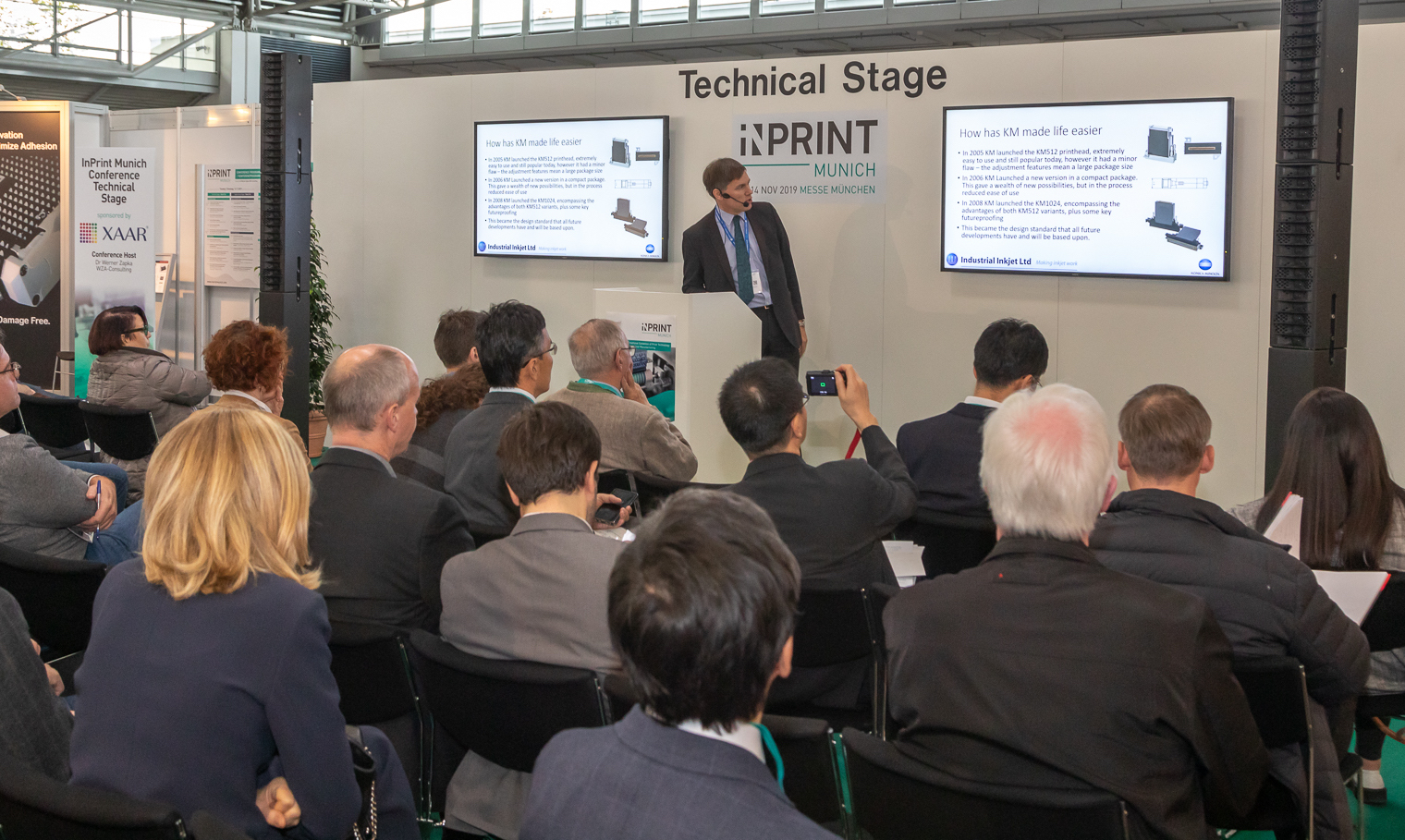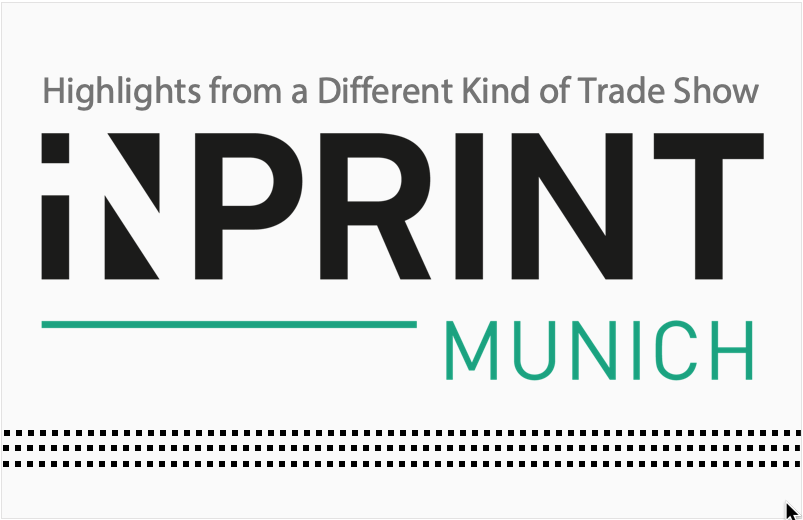The usual kind of trade show is: exhibitors present their products and visitors look around and possibly buy a product on offer. InPrint 2019 is different: visitors look for a solution to a problem rather than a readily available product. This can involve multiple technology providers and integrators for bespoke solutions. Accordingly, exhibitors offered a wide range of components including inkjet test equipment, colour management, inline measurement, inks, finishing, surface treatment, curing solutions, system integration, and obviously, inkjet heads.
InPrint is not about printing documents but about print as a manufacturing process. With the inaugural show 2014 in Hannover, InPrint is now an established event although the range of solutions shown has changed over time. At earlier events a greater number of printing systems were on display, the number declined and now mostly technology components and services are offered. There are still exceptions. For example the preview of a flatbed printer from Roland to print onto membrane switches and control panels in a range of shapes and sizes. Also markets addressed by InPrint have changed. While packaging print felt somewhat underrepresented this year, a lot of focus was on direct-to-shape print (including robotics) and printing on uneven surfaces like wood.
A number of interesting new technologies were launched at InPrint. Inkjet head developments took the centrepiece of interest. An increasing range of heads for the top end market for high quality graphic arts applications featuring 1,200 dpi resolution and 2-5 picolitre (pl) drop sizes propelled the recent growth of inkjet print. The latest addition to the field is Xerox, exhibiting the W-Series inkjet heads, used in the recently launched Baltoro. The same heads are available for OEM integrators and with the W2 model a two-colour head is about to become available with 600 dpi for each channel. Currently the heads are available as 40 and 64 kHz versions, with a faster 80 kHz version in development. The higher speed head will have the same form factor, hence upgrading should be fairly easy.
Fujifilm’s inkjet head subsidy Dimatix is launching two new heads. The tried and tested Starfire Series for robust industrial applications will get a 600 dpi resolution version, which will allow addressing more demanding applications in textile and corrugated in addition to the established ceramics printing market. The Si-MEMS family for graphic arts applications is going to be extended as well with the GMA head. Having a different form factor than the existing Samba heads the GMA head is well suited for scanning head uses. To be launched initially with 300 dpi early next year, a 600 dpi version is planned as well. Another interesting move from Fujfilm/Dimatix is offering subsystems from the JetPress (or JPress in the US market) to support inkjet integrators beyond mere heads and inks. Components range from capping and head cleaning stations to integrated printbars with ink circulation, manifolds, mounts and driver electronics. Additionally, image optimisation tools are available such as an inline scanner and software.
An important trend in inkjet heads is recirculating heads for industrial applications. Recirculating heads offer a better open time, a larger window for pressure, ink viscosity and prevent sedimentation. Xaar, an early manufacturer of recirculating heads, introduced the Ultra High Viscosity features to jet fluids with four times higher viscosity than achieved previously. Konica Minolta joined the range of recirculating heads with the KM1024. With the KM 1280 a new head for 450 dpi and 10 pl drops was announced to achieve a good compromise between resolution and throw distance. The head will be available in 2020. Seiko instruments is active in recirculating heads for three years and announced three new variants of their RC1536 heads: a two color version, a version of aqueous inks and a version with metal nozzle plate for industrial uses. With RCE a new version will launched soon that takes the resolution from 360 to 600 dpi.
There have been other new technology launches as well. Most notable is probably the progress on flexible packaging inks as well with Agfa and Marabu offering aqueous inks now. This would be a great progress for food-safe packaging.
An integral part of InPrint is an extensive conference program with tracks on technology and applications. Many shows have an educational program, but at InPrint this proved to be very lively and well attended. This is no surprise given that many visitors were looking for solutions to a specific problem or to gain an understanding on what is possible today. The conference program is providing visitors with excellent value, considering that other conferences charge hundreds of dollars or Euros. While the conference program might not have the detail and interaction level of something like the IMI inkjet conference, it provides a good overview on the technologies exhibited and a very cost-effective starting point for further exploration – with the added benefit that many topics can be investigated further at a nearby booth.
Another new approach is the consultancy corner, a first for an InPrint show. In the consultancy corner visitors were able to set up an appointment free of charge with a consultant to get advice on markets, technologies or solutions to solve a certain problem they have or to get an overview on possibilities available. About 10 consultants from FM Future or LMNS (a network of digital print consultants) were present with different areas of expertise. Apart from the recommendations offered, the consultants might be able point to an exhibitor as well. The advantage for the visitors is clear: getting vendor independent advice before heading to the booths.
The next instalment of InPrint will be 2020 in Milan. InPrint 2020 will be co-located with Viscom Italia 2020. Viscom Italia caters for large format printing and adjacent sectors. Viscom is organised by Reed exhibitions as well, so the organisers do not only see synergies in the audience, but on the organisational side as well. The show will take place from 22 – 24 October 2020, at Rho Fiera Milano.


